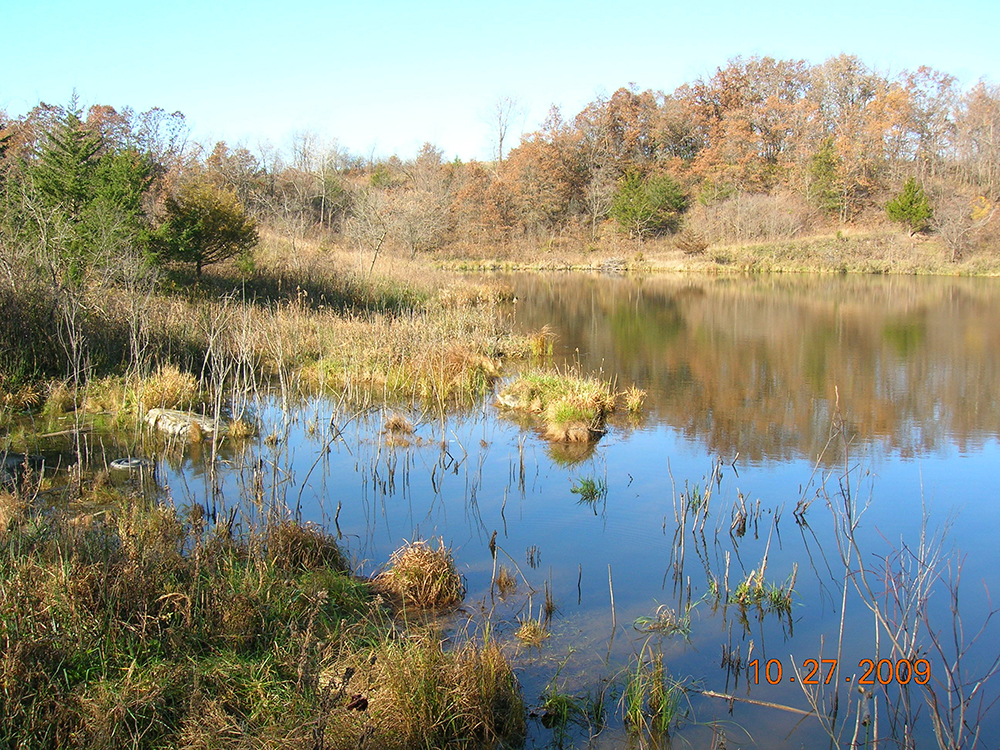Restoring Iowa's shallow lakes
By Sarah LeBlanc on March 21, 2017 in Blog
Iowa’s natural shallow lakes might not be fit for adventurous water sports, but that doesn’t mean they have nothing to offer. Consisting of rich but fragile ecosystems reliant on a balance of plants, nutrients and aquatic life, shallow lakes provide opportunities for fishing, hunting, exploration and chances to view native wildlife.
Shallow lakes are bodies of water ranging 6-8 feet at their deepest points. Before human intervention, they could be self-sustaining, going through natural low water cycles and ensuring that the ecosystem maintained a balance of species. Plants were free to grow — rooting sediment to the bottom of the water and keeping it healthy for the species that inhabit the lake. But significant landscape changes around these lakes and the presence of invasive species threaten the continued existence of these ecosystems. That’s why the Iowa DNR has a lake restoration program, and Iowa Natural Heritage Foundation has been able to help protect important land around these restoration projects.
The Iowa DNR takes a triangular approach to the lake restoration process, focusing on monitoring, assessment and restoration when tackling projects. To determine which properties are in most dire need of restoration, the Iowa DNR conducts fish surveys, notes the amount of migratory waterfowl or ducks that are moving through the area and looks for the presence of vegetation.
Along with restoring shallow lakes, the Iowa DNR and INHF are managing the land surrounding the water and manufacturing the natural cycles of these lakes. Lakes undergo dry cycles and droughts to eliminate unwanted populations, restore plant life and create a better habitat for the plant and wildlife species that visit them. The Iowa DNR helps to replicate these cycles by engaging in drawdowns in the fall, which drain the water from the lakes and kill fish under the ice in winter.
“The common carp (or other undesirable fish) do two things to the lake: They stir up the bottom sediments, and they like to root up any plants that are there or disturb them in a way so that no plants grow,” said Michelle Balmer with the Iowa DNR’s lake restoration program. “If we can remove those fish from the lake and go through a cycle of drawdown and then refilling, we can promote a lot of that aquatic vegetation growth and improve habitat.”
INHF works to protect land around shallow lakes across the state. In northwest Iowa, Emmet County’s Eagle Lake is an example of a healthy shallow lake. INHF has purchased three pieces of land around Eagle Lake, the most recent in 2011. Since those pieces were made public, the land has provided a buffer to the lake, and Eagle Lake has been free of undesirable fish and maintained a stable ecosystem.
The addition of this land expanded the wildlife management area to 870 acres. It is a popular spot for hunting and wildlife viewing, and by protecting and restoring the land around Eagle Lake, INHF, the Iowa DNR and the U.S. Fish and Wildlife Service have ensured that this piece of the Prairie Pothole region will improve water quality and remain intact for future generations.
 In contrast, the 262-acre Elk Lake in Clay County is in poorer condition. According to Iowa DNR Wildlife Management Biologist Bryan Hellyer, the lake lacks aquatic vegetation, which, along with nutrient loading from the watershed and the presence of undesirable fish, leaves the water in a murky and unhealthy state. Unless a shallow lake management plan is implemented or the lake undergoes a natural drought, Elk Lake will remain anchored to an unproductive cycle.
In contrast, the 262-acre Elk Lake in Clay County is in poorer condition. According to Iowa DNR Wildlife Management Biologist Bryan Hellyer, the lake lacks aquatic vegetation, which, along with nutrient loading from the watershed and the presence of undesirable fish, leaves the water in a murky and unhealthy state. Unless a shallow lake management plan is implemented or the lake undergoes a natural drought, Elk Lake will remain anchored to an unproductive cycle.
“Iowa’s shallow lake restoration projects are important because these natural shallow lakes require disturbance in order to keep them healthy and diverse, similar to prairies that receive prescribed fire or conservation grazing,” Hellyer said.
INHF recently purchased 58 acres of land adjacent to Elk Lake, including 1,200 feet of shoreline. When this land is transferred to the Iowa DNR, restored natural vegetation could slow the flow of sediment and provide a filter for the water entering the lake.
“What happens on the land around the lake, in the watershed, has a huge impact on the quality of the water within the lake,” said Heather Jobst, INHF senior land conservation director.
Iowa’s shallow lakes contain fragile and diverse ecosystems. This means that what happens in their watersheds and along their shorelines has a big impact on the lakes. Partnerships like those between INHF, Iowa DNR, other conservation agencies and local communities help to protect and maintain these lakes to improve water quality, create habitat and provide Iowans with opportunities to hunt, fish and view wildlife.